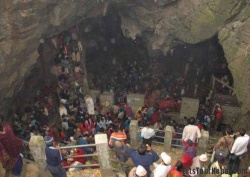Maratika Cave
Maratika Cave and Maratika Monastery (Maratika is also known as Haleshi or Halase, 27.19006°N 86.622391°ECoordinates: 27.19006°N 86.622391°E) are located in Khotang District in Nepal, circa 185 km south west of Mount Everest.
It is a venerated site of pilgrimage associated with Mandarava, Padmasambhava and longevity.
Mandarava and Padmasambhava realised a number of terma that had been elementally encoded as terma in Maratika Cave by Dakini Sangwa Yeshe, terma that number among the longevity teachings of Buddha Amitabha and given at the behest of Bodhisattva Avalokiteswara.
At Maratika Cave, Mandarava and Padmasambhava attained the Vidyadhara of longevity or long life.
Original sources
According to current scholarship, the caves of Maratika are referred to in Himalayan literature from the 12th century.
Kathang Zanglingma, a biography of Padmasambhava, a terma revealed and transmitted by Nyangrel Nyima Ozer, describes the original events which made the Maratika caves a sacred place for Vajrayana practitioners.
Haleshi Mahadeva or Maratika Cave- The famous natural cave in Khotang District, said to be the abode of Mahadeva while hiding away from the monster Bhasmasur.
It is famous pilgrimage centre in east Nepal for both Hindus and Buddhist and is also nicknamed as 'the Pashupatinath of the east'.
Huge religious fairs are observed here on Shivaratri and Bala Chaturdashi.
